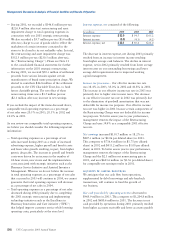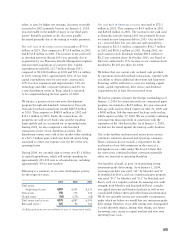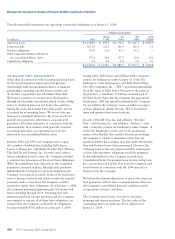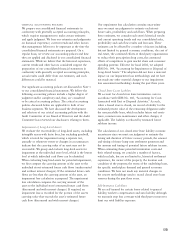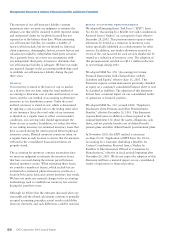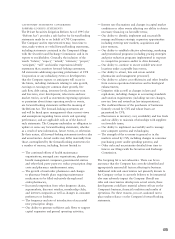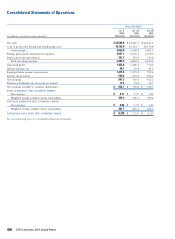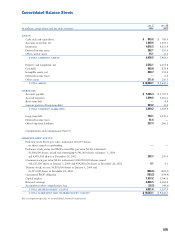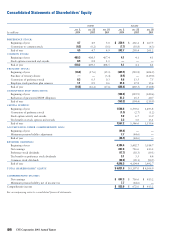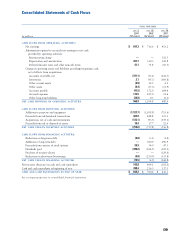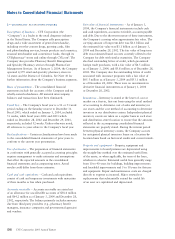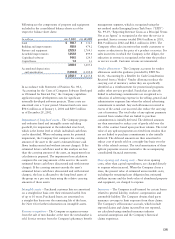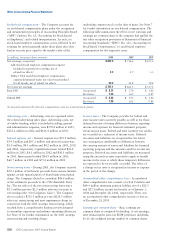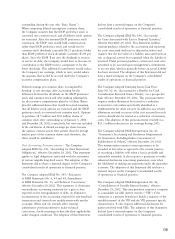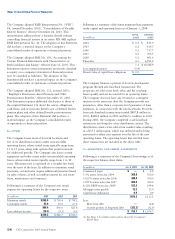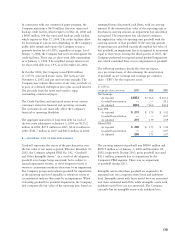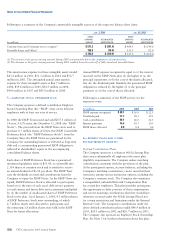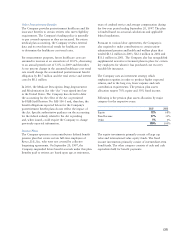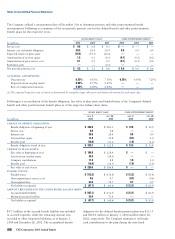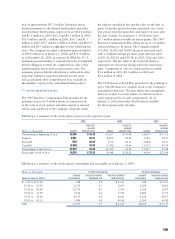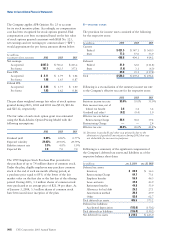CVS 2003 Annual Report Download - page 32
Download and view the complete annual report
Please find page 32 of the 2003 CVS annual report below. You can navigate through the pages in the report by either clicking on the pages listed below, or by using the keyword search tool below to find specific information within the annual report.1—SIGNIFICANT ACCOUNTING POLICIES
Description of business ~ CVS Corporation (the
“Company”) is a leader in the retail drugstore industry
in the United States. The Company sells prescription
drugs and a wide assortment of general merchandise,
including over-the-counter drugs, greeting cards, film
and photofinishing services, beauty products and cosmetics,
seasonal merchandise and convenience foods, through its
CVS/pharmacy®stores and online through CVS.com®
. The
Company also provides Pharmacy Benefit Management
and Specialty Pharmacy services through PharmaCare
Management Services. As of January 3, 2004, the Company
operated 4,179 retail and specialty pharmacy stores in
32 states and the District of Columbia. See Note 10 for
further information about the Company’s business segments.
Basis of presentation ~ The consolidated financial
statements include the accounts of the Company and its
wholly-owned subsidiaries. All material intercompany
balances and transactions have been eliminated.
Fiscal Year ~ The Company’s fiscal year is a 52 or 53 week
period ending on the Saturday nearest to December 31.
Fiscal 2003, which ended on January 3, 2004, included
53 weeks, while fiscal years 2002 and 2001 which
ended on December 28, 2002 and December 29, 2001,
respectively, included 52 weeks. Unless otherwise noted,
all references to years relate to the Company’s fiscal year.
Reclassifications ~ Certain reclassifications have been made
to the consolidated financial statements of prior years to
conform to the current year presentation.
Use of estimates ~ The preparation of financial statements
in conformity with generally accepted accounting principles
requires management to make estimates and assumptions
that affect the reported amounts in the consolidated
financial statements and accompanying notes. Actual
results could differ from those estimates.
Cash and cash equivalents ~ Cash and cash equivalents
consist of cash and temporary investments with maturities
of three months or less when purchased.
Accounts receivable ~ Accounts receivable are stated net
of an allowance for uncollectible accounts of $58.4 million
and $64.2 million as of January 3, 2004 and December 28,
2002, respectively. The balance primarily includes amounts
due from third party providers (e.g., pharmacy benefit
managers, insurance companies and governmental agencies)
and vendors.
Fair value of financial instruments ~ As of January 3,
2004, the Company’s financial instruments include cash
and cash equivalents, accounts receivable, accounts payable
and debt. Due to the short-term nature of these instruments,
the Company’s carrying value approximates fair value. The
carrying amount of long-term debt was $1.1 billion and
the estimated fair value was $1.1 billion as of January 3,
2004 and December 28, 2002. The fair value of long-term
debt was estimated based on rates currently offered to the
Company for debt with similar maturities. The Company
also had outstanding letters of credit, which guaranteed
foreign trade purchases, with a fair value of $6.5 million
as of January 3, 2004, and $5.8 million as of December 28,
2002. The Company also has outstanding letters of credit
associated with insurance programs with a fair value of
$65.5 million as of January 3, 2004 and $53.1 million
as of December 28, 2002. There were no investments in
derivative financial instruments as of January 3, 2004
or December 28, 2002.
Inventories ~ Inventory is stated at the lower of cost or
market on a first-in, first-out basis using the retail method
of accounting to determine cost of sales and inventory in
our stores and the cost method of accounting to determine
inventory in our distribution centers. Independent physical
inventory counts are taken on a regular basis in each store
and distribution center location to ensure that the amounts
reflected in the accompanying consolidated financial
statements are properly stated. During the interim period
between physical inventory counts, the Company accrues
for anticipated physical inventory losses on a location-by-
location basis based on historical results and current trends.
Property and equipment ~ Property, equipment and
improvements to leased premises are depreciated using
the straight-line method over the estimated useful lives
of the assets, or when applicable, the term of the lease,
whichever is shorter. Estimated useful lives generally range
from 10 to 40 years for buildings, building improvements
and leasehold improvements and 5 to 10 years for fixtures
and equipment. Repair and maintenance costs are charged
directly to expense as incurred. Major renewals or
replacements that substantially extend the useful life
of an asset are capitalized and depreciated.
Notes to Consolidated Financial Statements
(30) CVS Corporation 2003 Annual Report


